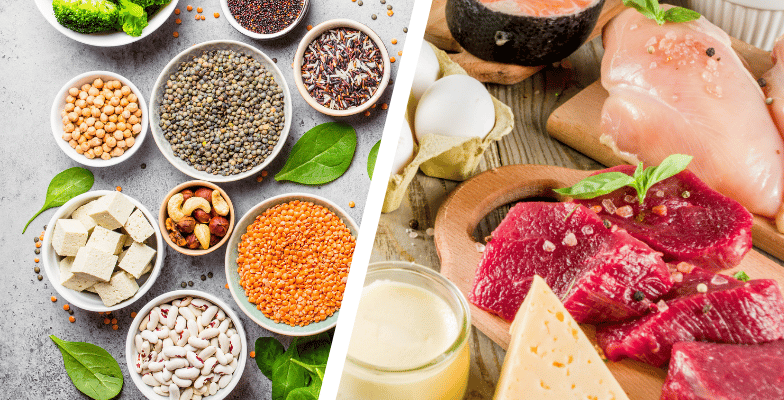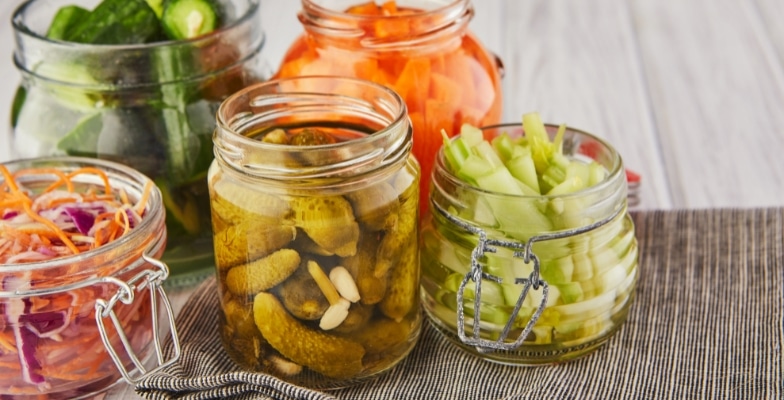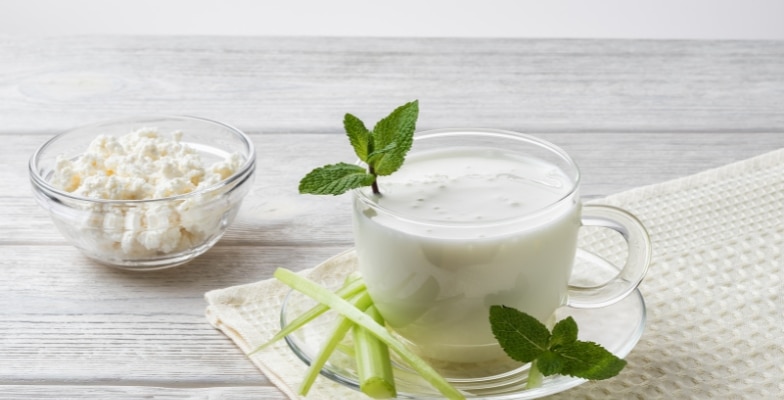Plant Protein Vs. Animal Protein | Which Is Better?
- Protein And Amino Acids
- Complete, Incomplete & Complementary Proteins
- Is Plant Protein Inferior To Animal Protein For Muscle-Building?
- Is Plant Protein Better Than Animal Protein For Overall Health?
- Conclusion & My Recommendation

Protein is an essential nutrient that our body needs for growth and maintenance. Proteins are the building blocks of muscle tissue and also serve as precursors for nucleic acids, hormones, vitamins, and other integral molecules.
No doubt, protein as a macronutrient is essential and should be consumed in adequate quantities daily, especially if you are an active adult. However, it’s not just the quantity of protein that matters, but the quality as well.
Also, is the protein plant-based or animal-based? Some experts suggest that for muscle growth, animal-based protein is superior to plant-based protein, whereas vegans and some vegetarians disagree!
Who’s Right?
Let’s find out.
Protein And Amino Acids
Proteins are made up of amino acids, which are the building blocks of the human body. When you eat protein, your body breaks it down into its constituent parts- amino acids.
Twenty different amino acids join together in various combinations to make all types of proteins. Our bodies can’t make nine of these amino acids; hence they are known as essential amino acids. We need to get essential amino acids from our diets.
Please note that histidine is only essential for infants.
There are eleven amino acids that can be manufactured by the body and are termed non-essential amino acids. Since the body makes them, there is no need to get them from your diet. Dietary protein sources are categorized according to how many of the essential amino acids they provide.
Complete, Incomplete & Complementary Proteins
Dietary protein sources are categorized according to how many of the essential amino acids they provide.
Complete Protein
A complete protein source is one that provides all the essential amino acids. Complete proteins are also referred to as high-quality proteins. All animal-based food sources like meat, poultry, fish, milk, eggs, and cheese are complete protein sources.
Incomplete Protein
An incomplete protein is one that is low in one or more of the essential amino acids. Most plant-based food sources such as grains, lentils, and rice are incomplete proteins. The only complete plant-based foods are soybeans, tofu, and quinoa.
Complementary Proteins
Complementary proteins are two or more incomplete protein sources that together provide adequate amounts of all essential amino acids.
For example, rice contains low amounts of the essential amino acid lysine and high amounts of the essential amino acid methionine. In contrast, dry beans contain greater amounts of lysine and lesser amounts of methionine. Together, rice and beans provide adequate amounts of all the essential amino acids.
Always Combine Plant-Based Proteins!
So, a point to remember is that you need a variety of plant-based protein foods to ensure your body is getting all the essential amino acids, as most plant-based proteins are deficient in one or two essential amino acids.
A huge and popular myth you may have come across is that you need to combine specific plant-based protein sources to ensure that a given meal has all the amino acids. You do not need to do this! It’s okay to eat a variety of plant-based proteins any time during the day and not necessarily in the same meal. 1https://health.clevelandclinic.org/do-i-need-to-worry-about-eating-complete-proteins
Is Plant Protein Inferior To Animal Protein For Muscle-Building?
When it comes to comparing plant protein to animal protein with regard to muscle growth, we need to look at scales of measurement that determine the protein quality of a given source.
The Two Popular Scales Of Measurement
Biological Value (BV)
Protein Digestibility Corrected Amino Acid Score (PDCAAS)
Let’s briefly understand each method and see which is better from a practical standpoint.
Biological Value (BV)
Biological value (BV) is a scale of measurement used to determine what percentage of a given nutrient is utilized by the body. This scale is most frequently used for proteins. Proteins, as we are aware, are one of the significant sources of nitrogen in the human body.
The BV of a protein is the amount of nitrogen retained in the body divided by the amount of nitrogen absorbed from that protein.
The Formula For BV Of Protein = (Nr /Na)* 100
N= nitrogen
r= nitrogen that is retained in the body to be used by cells and tissues.
a= nitrogen absorbed into the body by the digestive system.
A BV value of 100 would indicate that the body fully utilized a given protein and none was lost. The drawback of this method is that BV is affected by many variables like calorie intake, recent diet, age, sex, and so forth.
For example, as overall protein intake goes down, the BV of any protein that is ingested goes up. Milk protein has a BV of 70 with a protein intake of 0.5g/kg and a BV of 100 with a protein intake of 0.2g/kg.
This does not mean one should lower protein intake to increase the BV of a given food source. The overall nitrogen intake will still be higher at high protein levels, i.e., 70% of 0.5g/kg is 0.35g/kg, which is more than 0.20g/kg (100% of 0.2g/kg)!
It’s reasonable to conclude that BV is useful for people who eat lower amounts of protein, but it is not ideal for everyone. Exercise and workouts can also have a positive effect on nitrogen retention, thus giving a false higher BV.
Another limitation of BV is that it assumes that protein is the only source of nitrogen in the human body, which is not true. Because there are other sources of nitrogen, this measure just gives a rough overall estimate.
Two other measures which are similar to BV are Net Protein Utilization (NPU) and Protein Efficiency Ratio (PER). BV is superior to these methods, so there is no point in discussing these. However, a method called PDCAAS replaced the BV scale of measurement in 1993, as it takes a protein source’s amino acid profile into account as well. 2https://en.wikipedia.org/wiki/Protein_Digestibility_Corrected_Amino_Acid_Score
Let’s briefly discuss PDCAAS.
Protein Digestibility Corrected Amino Acid Score (PDCAAS)
PDCAAS rating evaluates the quality of a protein based on the needs of humans. (The BV and PER methods were developed based on the amino acid requirements for growing rats.) PDCAAS uses the amino acid profile of two- to five-year-old humans (who are the most demanding age group, nutritionally speaking). See the table below.
The digestibility of a given protein is also accounted for. The highest possible PDCAAS score is 1.0. A given protein source with this rating will provide 100% or more of the essential amino acids required.
The limitation of the PDCAAS score is that since 1.0 is the highest rating, a protein source with a rating higher than 1.0 is rounded back to 1.0, causing its true protein quality score to be underrepresented.
Another limitation of PDCAAS is that it overestimates protein quality. PDCAAS analyzes feces, and therefore it does not take into consideration where the proteins have been digested.
In simple words, PDCAAS looks at how much protein was absorbed in both the small and large intestines. Once the protein crosses the small intestine and enters the large intestine, it is unlikely to be used for protein synthesis and is mainly food for the microbiome.
To combat this limitation, in 2013, a new scale was proposed called the DIAAS 3https://en.wikipedia.org/wiki/Digestible_Indispensable_Amino_Acid_Score, which looks at how much protein is absorbed in the large intestine after it leaves the small intestine.
Now, let’s see the essential amino acid requirement for one- to three-year-old children, which is used as a reference point for the PDCAAS scale. (Adults require less essential amino acids than growing children.)

Now, it is quite clear from the tables above that the essential amino acid profile of animal-based proteins is more than sufficient for adults. However, vegetarian proteins, like soy, beans, legumes, and rice, do not provide all of the essential amino acids in amounts sufficient to meet adult requirements.
This re-emphasizes the fact that combining vegetable protein is necessary to get the minimum daily requirement of essential amino acids. Therefore, the most valuable tip from this article for a vegan is that you need to combine two or more sources of protein to ensure that you get sufficient quantities of all essential amino acids.
When it comes to muscle building, a debate has been going on for decades over branched-chain amino acids, or BCAAs (particularly leucine), having a special ability to trigger muscle protein synthesis.
A multimillion-dollar industry exists just selling BCAA’s in supplement form, pills and powders!
BCAAs, as you probably know, are leucine, valine, and isoleucine. Does this mean that if you include more BCAAs by choosing animal-based protein in your diet, it will stimulate a higher muscle protein synthesis and therefore help you build more muscle?
Not according to Robert R. Wolfe, who published a study in the Journal of the International Society of Sports Nutrition titled ‘Branched-chain amino acids and muscle protein synthesis in humans: myth or reality?’ 4https://jissn.biomedcentral.com/articles/10.1186/s12970-017-0184-9
In this 2017 study, the author explains that most of the studies that concluded BCAAs have a special ability to increase muscle mass via stimulating more muscle protein synthesis were done on rats! And rat studies have limited relevance to human responses, he further adds.
There are very few studies done on humans, but both studies done on rats and studies done on humans concluded a surprising fact. 5https://www.ncbi.nlm.nih.gov/pubmed/2174312?dopt=Abstract, 6https://www.metabolismjournal.com/article/0026-0495(95)90047-0/pdf BCAA infusion decreased the rate of muscle protein synthesis and the rate of muscle protein turnover.
The conclusion of the author was,
When all evidence and theory are considered together, it is reasonable to conclude that there is no credible evidence that ingestion of a dietary supplement of BCAAs alone results in physiologically significant stimulation of muscle protein.
What about the individual effects of leucine on increased muscle growth? Well, some studies concluded that leucine is not only a precursor for muscle protein synthesis but also plays a role as a regulator of intracellular signaling pathways that are involved in the process of protein synthesis. 7http://www.ncbi.nlm.nih.gov/entrez/query.fcgi?cmd=Retrieve&db=PubMed&dopt=Abstract&list_uids=16365096
Another study concluded that leucine is the key factor responsible for the anabolic properties of a meal and the maximization of muscle protein synthesis. 8https://www.researchgate.net/publication/288150322_Optimal_protein_intake_to_maximize_muscle_protein_synthesis_Examinations_of_optimal_meal_protein_intake_and_frequency_for_athletes A few more studies indicate that animal protein has a greater ability to enhance muscle protein synthesis and support muscle mass than plant-based proteins. 9https://www.ncbi.nlm.nih.gov/pubmed/30621129, 10https://www.ncbi.nlm.nih.gov/pubmed/22698458
However, there are a few studies that conclude otherwise. 11https://www.ncbi.nlm.nih.gov/pubmed/28444456, 12https://jissn.biomedcentral.com/articles/10.1186/s12970-017-0184-9 One drawback of studies related to leucine is that almost all of them are done using supplements instead of whole foods. 13https://www.ncbi.nlm.nih.gov/pubmed/6732186/, 14 https://www.ncbi.nlm.nih.gov/pubmed/6463337, 15 https://www.ncbi.nlm.nih.gov/pubmed/6544056/
At the same time, it is not clear whether the subjects’ increase in muscle growth was because of the overall increase in protein intake or just because of supplementation with the branched-chain amino acid leucine.
Bottom line
Looking at all evidence, the amino acid leucine may be responsible for anabolic signaling, thereby increasing muscle protein synthesis.
However, more research is needed to conclude that the higher percentage of BCAAs in animal protein (especially the leucine content) is responsible for additional muscle growth when compared with plant-based protein.
Is Plant Protein Better Than Animal Protein For Overall Health?
All proteins, whether animal-based or plant-based, come with ‘extras.’ These ‘extras’ can be either beneficial or harmful for the human body. Beneficial extras are micronutrients, while compounds like hormones, antibiotics, etc., are harmful extras that are bad for your health.
Health has always been as important to me as changes in body composition. After all, what’s the point of looking good when you don’t feel good?
Animal-Based Proteins And Good ‘Extras’
Let’s first discuss the beneficial extras that are abundant in animal proteins.
Zinc
The RDA for zinc is 8-11mg/day. Meats are high in zinc. Dairy products also have adequate amounts of zinc. If you are a vegan or vegetarian who does not eat eggs and dairy products, you may be deficient in zinc.
Even though legumes like chickpeas, dal, etc., contain adequate amounts of zinc, they also contain phytates. Phytates are antinutrients that inhibit the absorption of zinc. This means zinc is not absorbed effectively from legumes.
Suggestions For Vegans And Vegetarians To Increase Zinc In Their Diet
-A few times a week, eat a handful of nuts (including cashews), which have a good amount of zinc.
-Soak legumes like dal, rajma (kidney beans), and chole (chickpeas) in water before you cook them. Better yet, a few varieties like mung beans and channa should be sprouted for increased absorption of not only zinc but other minerals as well.
Vitamin D3
Even though most experts claim that one gets enough vitamin D from animal foods, I disagree.
Yes, it’s true that animal foods, which include eggs and dairy, have a small amount of vitamin D, but the daily requirement for vitamin D is pretty high, and direct exposure to sunlight is the only way to get the optimal dose.
Related Article: Over A Billion People Worldwide Are Vitamin D Deficient….Are You One Of Them?
Vitamin B12
This essential vitamin is mainly found in animal foods such as beef liver, salmon, milk, and eggs. A large percentage of vegans and vegetarians (if they don’t eat eggs or dairy products) may be deficient in vitamin B12, as no plant food contains it. Ideally, if you are a strict vegan, it’s best to supplement your diet with vitamin B12.
Omega-3s
The benefits of omega-3s are immense. For starters, they reduce inflammation and might help lower the risk for chronic diseases such as heart disease, cancer, and arthritis.
Related Article: Omega 3 Fatty Acids Benefits And Daily Requirement
Now, plant food such as flaxseeds and walnuts contain omega-3 fats called alpha-linolenic acid (ALA). It is easier for fish to convert alpha-linolenic acid from algae and other sea plants into EPA and DHA; humans can only do so to a minimal degree.
Although ALA is not harmful, as vegans or vegetarians, you cannot get enough omega-3 in your diet, and I do recommend a high-quality supplement like krill oil to boost your omega-3 levels.
Ok, so these were the beneficial extras you get when you eat protein from animal sources.
Please note the purpose of the above section was to inform all of you lovely vegetarians and vegans that it’s possible to easily get all the nutrients you need if you eat a variety of plant-based foods and take supplements when required.
Now, let’s discuss the harmful extras that come along with animal-based meats.
Animal-Based Proteins And Bad ‘Extras’
First, let me make a clear distinction between fresh meats and processed meats. Processed meats include, but are not limited to, ham, beef jerky, sausages, salami, pepperoni, hotdogs, smoked meats, and canned meats.
Fresh meats are meats in their raw form, like beef, pork, lamb, chicken, etc. Meats are processed to enhance flavor and increase shelf life.
Nitrates are the preservatives most commonly used to improve the flavor and appearance of meats. Nitrates also help prevent the bacteria inside the meat from growing and give the meat the pinkish-red color that makes it attractive to buyers!
Let me quickly give you a biochemistry lesson on nitrates and nitrites, and let’s truly understand if they are as harmful as conventional wisdom states. Nitrates and nitrites are chemical compounds that contain oxygen and nitrogen atoms.
Please note most of the nitrates and nitrites you consume are from your vegetables and not from processed meats!
Carrots, leafy greens, and other vegetables contain these compounds. Organic vegetables will obviously have less, as they are not sprayed with nitrate fertilizers. Most nitrites are not consumed directly but are converted from nitrates by bacteria found in our mouths.
Now, you’ll be surprised to know that nitrates and nitrites are actually beneficial. This is because of their ability to contribute to nitric oxide formation. Nitrogen gas is beneficial, especially for older adults, as it helps dilate blood vessels and lower blood pressure, besides having many other health benefits.
However, nitrates found in processed meats combine with the protein in the meat to form nitrosamines. High-heat cooking can also cause nitrites to form nitrosamines.
Nitrosamines are carcinogenic compounds that increase the risk of certain types of cancer, like bowel cancer. 16https://www.ncbi.nlm.nih.gov/pubmed/12421882, 17https://www.ncbi.nlm.nih.gov/pubmed/16865769 Barbecuing, frying, etc., can also produce other carcinogenic chemicals such as heterocyclic aromatic amines (HAA) and polycyclic aromatic hydrocarbons (PAH), which increase the risk of certain cancers. 18https://www.ncbi.nlm.nih.gov/pubmed/15513831, 19https://www.ncbi.nlm.nih.gov/pubmed/10944558
Since there is little protein in vegetables, hardly any nitrosamines are formed from nitrates in vegetables. Furthermore, other nutrients, like vitamin C, fiber, etc., which are abundant in vegetables, are known to reduce the formation of nitrosamines.
The problem with processed meats does not end with nitrates/nitrites. The salt added to these products to increase shelf life is also a big concern.
It’s common knowledge that high amounts of salt and other preservatives are added to fresh food items to preserve them. Now, there is clear evidence that sodium chloride (table salt) is known to increase blood pressure and, therefore, the risk of heart disease. On average, processed meat contains four times more sodium and 50% more nitrate preservatives than fresh meats. 20https://www.hsph.harvard.edu/news/press-releases/processed-meats-unprocessed-heart-disease-diabetes
Renata Micha et al. conducted a systematic review and meta-analysis of about 1,600 studies comprising a total of 1,218,380 subjects. The study, conducted by the Harvard School of Public Health, concluded that eating processed meats, such as canned meats, sausages, etc., was associated with a 42% higher risk of heart disease and a 19% higher risk of type 2 diabetes. 21https://www.hsph.harvard.edu/news/press-releases/processed-meats-unprocessed-heart-disease-diabetes
Surprisingly, the researchers did not find any evidence of a higher risk of heart disease or type 2 diabetes among individuals who ate unprocessed red meat such as beef, pork, or lamb.
They concluded that,
To lower the risk of heart attacks and diabetes, people should consider which types of meats they are eating. Processed meats such as bacon, salami, sausages, hot dogs, and processed deli meats may be the most important to avoid.
This study was supported by the Bill & Melinda Gates Foundation; the World Health Organization Global Burden of Diseases, Risk Factors, and Injuries Study; the National Heart, Lung, and Blood Foundation; and the National Institutes of Health. 22https://www.hsph.harvard.edu/news/press-releases/processed-meats-unprocessed-heart-disease-diabetes
An article published on BBC titled ‘Processed Meat, ‘Early Death’ Link’ concluded that diets high in processed meat were linked to cardiovascular disease, cancer, and early death! 23https://www.bbc.com/news/health-21682779 The article described a study that was 13 years long and included 10 European countries.
Yet another study in the UK followed 262,195 women over seven years and concluded that consumption of processed meat, but not red meat, may increase the risk of breast cancer. 24https://www.ncbi.nlm.nih.gov/pubmed/29274927
Yet another study came to the same conclusion that processed meats and not red meats are associated with a higher incidence of heart disease and diabetes. 25https://www.ncbi.nlm.nih.gov/pubmed/20479151
Despite conventional wisdom, I like to believe that the saturated fats in fresh red meats are not bad for you.
Related Article: Saturated Fat: Good Or Bad?
It’s pretty clear that a non-vegetarian should eat fresh meats instead of processed meats. Another thing to consider concerning meats is whether the meat comes from CAFOs or is pasture-raised.
Unfortunately, 99% of meat, dairy, and eggs in the US come from factory farms or CAFOs (Confined Feeding Animal Operations). The situation is the same for fish. 26https://www.livekindly.co/99-animal-products-factory-farms Animals from CAFOs live in poor conditions. To increase survival rates, they are pumped with antibiotics. They are also fed hormones to increase their growth.
After all, meat is sold by weight. The faster an animal grows and the heavier the meat, the bigger the profits for the companies that sell them! Besides these issues, factory farms are among the biggest contributors to climate change.
I did a project for my master’s titled ‘How Pasture-Raised Farming Can Save The Environment.’
Some of the interesting facts I discussed in that project were,
-Products from pasture-raised animals are nutritionally superior to products from grain-fed factory animals. They are lower in fat and calories.
-Pasture-raised products are high in omega-3s and vitamin E and are free from antibiotics, hormones, and other diseases like e-coli.
-Meat from grass-fed animals requires only one calorie of fossil fuel energy to produce two calories of food as opposed to grain-fed animals (in CAFOs) that require 35 calories of fossil fuel.
In conclusion, pasture-raised farming does no harm to the environment and is a great example of sustainable agriculture. If you want to find out more about how we can feed 10 billion people by 2050 without destroying the planet, you can watch this video about it. 27https://www.youtube.com/watch?v=vpTHi7O66pI
The bottom line is, if you are a regular meat eater and also consume eggs and drink milk, I strongly urge you to be conscious of where your animal-based protein is sourced, not only for the sake of the environment but for better health for yourself and your family.
Also, try to go organic when it comes to buying fruits and vegetables. If you don’t have the budget to buy everything organic, then prioritize items. For example, certain fruits and veggies are heavily sprayed with pesticides. Prioritize avoiding those. 28https://www.downtoearth.org/environment/organic-vs-conventional-farming/dirty-dozen-most-heavily-sprayed-foods
Plant-Based Protein And Good ‘Extras’
The following micronutrients are missing from animal foods.
Fiber
There is no fiber in animal foods, so it’s imperative to eat fruits, vegetables, whole grains, oats, and other plant-based foods to get your daily dose of fiber. The optimal fiber intake for men is 35-40g/day. For women, fiber intake should be 25-30g/day.
The benefits of fiber are immense and include reduced risk of heart disease and lower risk of colon cancer. Fiber also helps increase satiety and the feeling of fullness, which is an important factor when it comes to weight loss.
Vitamin C
Vitamin C is mostly found in fruits and vegetables like tomatoes, kiwis, oranges, and papayas. Very few animal foods contain vitamin C, but some, like beef liver, and oysters, do.
The requirement for vitamin C is around 65mg per day, but optimal intake could be as high as 500 mg-1 g/day. Excess vitamin C is excreted through urine. High doses could have benefits like boosting immunity and warding off illness.
Conclusion & My Recommendation
After analyzing scores of scientific references, let me conclude by saying this.
Your muscle growth results depend mostly on your total protein intake.
If your total protein intake is optimal and within the range of 1.2-2g/kg of body weight per day, then protein quality (animal or plant-based sources) will not matter much!
Find out your exact protein requirement based on the type of activity you do. Try to consistently consume close to ~1.6g/kg of protein (or slightly more but < 2g/kg) if your goal is to gain weight and muscle.
Related Article: How Much Protein Should I Eat Per Day?
Then comes your dietary preference.
Recommendations For Vegetarians And Vegans
If you are predominantly a vegetarian, there is no need to shift to animal-based proteins just because a few studies have concluded that they are better. The studies have their limitations, and what truly brings amazing results is being consistent.
How Do You Stay Consistent With Your Diet?
You eat what you love to eat, what your culture and preferences dictate! So, suppose you are a vegetarian and include dairy and eggs in your diet. In that case, there should be no issue with getting all the essential amino acids, including enough leucine and other BCAAs, for optimal muscle growth.
If you are a vegan or a pure vegetarian, I would recommend eating a variety of foods that are protein-based on a daily basis. Protein combining is important to ensure a steady supply of essential amino acids.
Some Examples Of Plant-Based Foods High In Protein
-Dal (all varieties)
-Beans (all varieties)
-Nuts (all types)
-Seeds like chia seeds and flaxseeds
-Oats
-Quinoa
-Vegetables (both cooked and raw, all varieties)
-Whole wheat (roti, etc.)
-Rice (Ideally brown or any unprocessed variety)
Lastly, it’s a good idea to supplement your diet with vitamin B12 if you are a vegan. Vitamin B12 is abundant in whole milk and whole eggs. If you are a vegetarian who includes these animal-based foods, then you are fine. But for vegans, supplementing with vitamin B12 is essential.
Recommendations For Non-Vegetarians
If you are not a vegetarian, then getting enough high-quality protein should not be a problem for you. Just ensure your total protein intake is within the recommended range.
However, as mentioned above, the source of animal protein matters. Livestock is treated badly and, compared with grass-fed animals, produce inferior meats that include compounds like antibiotics, hormones, etc., that can be very harmful to your body and may lead to a variety of diseases over time.
So, I Suggest 3 Things
1) Do your best to choose meats, milk, and eggs from the highest quality sources, ideally from grass-fed sources.
Yes, grass-fed animal foods will cost you more, but if your health is a priority, it’s possible to adjust your budget accordingly. Grass-Fed Chickens 🙂 Happy & Healthy!
The availability of grass-fed animal foods may be an issue, so you will need to do a thorough search. If you are persistent, I am optimistic you will be able to find something superior to what you are currently consuming. If you cannot find grass-fed meats, choose organic meats, which have no added hormones or antibiotics.
2) Choose fresh meats over processed meats like ham, beef jerky, salami, canned meats, hotdogs, etc.
There is clear evidence that processed meats are bad for you and can increase the risk of cardiovascular disease. However, it’s ok to have a hot dog or any other form of processed meat once in a while.
3) If you hardly eat any plants, chances are your diet is deficient in fiber, vitamin C, and vitamin E.
My recommendation is to ensure that you eat generous servings of green vegetables, ideally in raw form, with your meals. I recommend at least 500g to 1kg of raw vegetables and fresh fruits every day in your diet. This will ensure optimal fiber intake.
Plant-based foods will also provide you with much-needed vitamins C and E. Do also include fruits that contain vitamin C, like oranges, guava, papaya, etc. In addition, it’s an excellent idea to start eating other plant-based foods, like beans and pulses, at least twice or even thrice a week for variety.
I promise this won’t slow down your muscle growth (if that’s what your aim is), and the added variety may be just the thing you were looking for!
What do you think about this article? Have any questions? Let me know in the comments section below!

Skill-Based Education.
Global Recognition.
Powerful Community Building
Secure a certificate of completion in as little as a day by graduating from one of our free courses.
Get Access to Our Free Courses. No Credit Card Required.

Fabulous Body Membership
Your All-Access Pass to A Fabulous Body & A Rewarding Career
25+ Certificate Courses & Programs, All Included
15 Day Free Trial, 100% Money-Back Guarantee
About Akash Sehrawat
Akash is a creator of 25+ programs and certificate courses in which more than 200,000 students have enrolled both on Udemy and Fabulous Body's native platform. Akash is also an author of three books that can be found on Amazon. His answers on Quora have gathered more than 12 million views in less than a year.











Sir it was very informative and helpful thank you.
Hii sir this is prerna lade!! It was very informative and I guess the animal protein is best!!!
I agree with everything else in this article, except this part:
“Although ALA is not harmful, as vegans or vegetarians, you cannot get enough Omega-3’s in your diet, and I do recommend a high-quality supplement like Krill Oil to boost your Omega-3 levels.”
It sounds like you are suggesting vegetarians and vegans to take krill oil. Taking krill oil is completely against these diets as it’s fully animal sourced.
There are excellent algae oil options nowadays, containing excellent DHA-EPA Omega-3 ratios. All extracted from algae.
Hi Akash.
I am your student and pursuing 7 different courses of yours presently.
The above article is awesome covering entire aspects relevant and more than what is needed for a person looking for Plant Protein vs. Animal Protein.
I am not able to share this through LinkedIn. When I click on share with LinkedIn it pops an error “Bummer, something went wrong. The redirect_uri does not match the registered value”
Can you please check with your hosting partner about this issue??
Best
Tulasi Krishna.
Thank you Prerna:)
That’s not what I concluded! Both are fine as long as you follow the recommendations.
I agree with you Will. I will update this soon. Thank you for your feedback!
Thank you for your comments Tulasi:) I double-checked the issue about the share and it seems to be working fine. Perhaps you can try using a different browser?
Excellent article and great read as part of the fitness programme I am taking you on Udemy. Very well researched and bias balanced.
Personally I eat predominantly plant based but with occasional egg or non-farmed (wild) fish added to my diet.
I would like to add that Chia seeds and Hemp seeds are also complete proteins and with a high protein count. Avocado is also a complete protein fruit but has a low protein content but high in minerals and essential fats etc.
From a fitness and health coaching perspective I would advise clients to be predominantly plant based as their age increases in order to sustain cardiovascular health. Once past 40 years of age this becomes more important.
Enjoying the course a lot, I will leave a 5* rating!
Thank you for your comments Dan! Chia and hemp seeds are great and so are Avocados. I am glad you are enjoying the course. I wish you all the best.
Good Stuff sir
Thanks!
Great article Akash.
Thanks Siddharth:)
I totally think that is a great idea to mix vegan meals at least twice a week that will help in reaching our fiber intake goals plus save some money from consuming so much meat on a daily specially grass fed which is more expensive. Thanks for confirming this I had some doubts about mixing vegan protein with animal protein for max results but now i am clear.
Thank you!
Good to know this Yazmin!